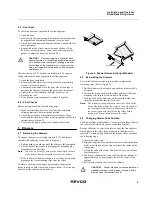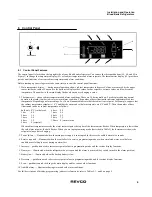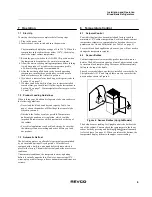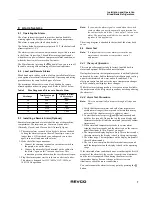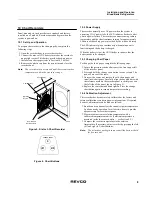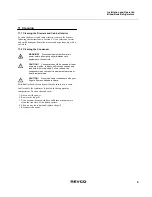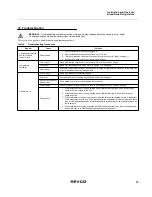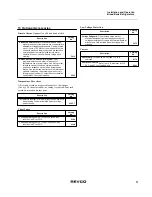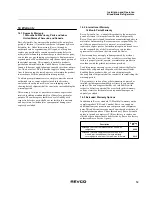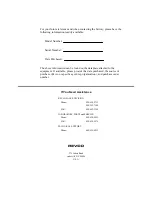
2
Installation and Operation
Blood Bank Refrigerators
3
Unpacking and Inspection
At delivery, examine the exterior for physical damage while the
carrier’s representative is present. If exterior damage is present,
carefully unpack and inspect the unit and all accessories for
damage.
If there is no exterior damage, unpack and inspect the equipment
within five days of delivery. If you find any damage, keep the
packing materials and immediately report the damage to the
carrier. Do not return goods to Revco without written
authorization. When submitting a claim for shipping damage,
request that the carrier inspect the shipping container and
equipment.
4
Installation
4.1
Location
Install the unit in a level area free from vibration with a minimum
of 6 inches of space on the sides and rear and 12 inches at the top.
Do not position the equipment in direct sunlight or near heating
diffusers, radiators, or other sources of heat. The ambient
temperature range at the location must be 59 to 90
°
F
(15 to 32
°
C).
4.2
Wiring
CAUTION!
Connect the equipment to a separate,
dedicated, power source with the correct voltage.
Power fluctuations or incorrect voltage can result in
severe damage to the equipment.
DANGER!
For personal safety and trouble-free
operation, this unit must be properly grounded before
it is used. Failure to ground the equipment may cause
personal injury or damage to the equipment. Always
conform to the National Electrical Code and local
codes. Do not connect unit to already overloaded
power lines.
Always connect the equipment to a dedicated (separate) circuit.
Electrical codes require fuse or circuit breaker protection for
branch circuit conductors. Use time delay fuses for #12 AWG
circuits.
For all blood bank models, the wiring diagram is attached to the
back of the cabinet.
4.3
Leveling
The unit must be level. Rotate the leveling screws, located under
the front corners of the unit, until the unit is level. If the floor is
seriously out of level, you may need to shim the corners with thin
sheets of metal.
Note:
Use thin sheets of metal to level units equipped with
optional casters.
4.4
Glass Doors
All Space Saver and Upright models have standard dual-pane
glass doors, insulated to prevent condensation.
Glass door tension on Upright models can be adjusted. Check the
door operation. If the self-closing doors do not work properly,
make sure the unit is level. If the unit is level and the doors do
not self-close, adjust the door tension.
CAUTION!
Do not overtighten the tension as
damage to the equipment can result.
WARNING!
Disconnect equipment from main
power before attempting any maintenance to
equipment or its controls.
You can use a regular screwdriver to adjust spring tension and
center each door on its frame. The adjustment screws (“torque”
for tension and “sag” for door placement) are located on the
bottom hinge bracket (shown below in Figure 1).
Figure 1. Bottom Hinge Bracket for Glass Doors
Hinged glass doors can be propped open with metal braces at the
bottom hinges. Open the door 90 degrees or until you feel some
resistance. Push the door open past the resistance and the metal
braces engage. To close the door, push it toward the unit (past the
resistance).
Torque
Sag



